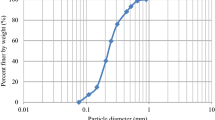Abstract
This research paper presented the influence of variables such as sand gradation, relative density, curing time and condition and sodium silicate content on the strength characteristics of sodium silicate-formamide injected sand. To start with, the viscosity, gel time, and syneresis of sodium silicate-formamide grouts were studied. With the increase of sodium silicate content in the grout mix, the setting time of sodium silicate-formamide solutions decreased but the viscosity increased. Additionally, an increase in silicate content increased the amount of syneresis of grouts up to a specific point. The grouts with various silicate contents successfully penetrated the sand specimens with different grain size distributions and relative densities. The wet-cured and the air-dried samples were subjected to unconfined compressive (UC) and undrained-unconsolidated (UU) triaxial tests at various time intervals. The UC strengths of wet-cured as well as the air-dried specimens varied from 0.11 to 0.80 MPa and from 0.48 to 2.52 MPa respectively at the end of the 150th day. Moreover, as the internal friction angles of wet-cured and air-dried specimens ranged from 36° to 43° and from 41° to 50° the cohesion intercepts of wet-cured and air-dried specimens varied from 40.78 to 161.68 kPa and from 85.84 to 348.62 kPa respectively at the end of 150th day. As the silicate content of grouts increased, UC and UU strengths of air-dried and wet-cured samples increased. The UC and UU strengths of injected sand specimens under wet-cured condition reduced with time owing to syneresis. However, the UC and UU strengths of grouted specimens under air-dried condition increased with time. Though the strength of grouted sand samples was slightly increased with the increase of relative density, it was found to be highly variable with the grain size distribution.



















Similar content being viewed by others
References
ASTM D854-02 (2007) Standard test method for specific gravity of soil solids by water pycnometer. ASTM International, West Conshohocken
ASTM D4253-00 (2002) Standard test method for maximum index density and unit weight of soils using a vibratory table. ASTM International, West Conshohocken
ASTM D4254-00 (2002) Standard test method for minimum index density and unit weight of soils and calculation of relative density. ASTM International, West Conshohocken
ASTM D2196-15 (2015) Standard test methods for rheological properties of newtonian materials by rotational viscometer. ASTM International, West Conshohocken
ASTM D2850-15 (2015) Standard test method for unconsolidated-undrained triaxial compression test on cohesive soils. ASTM International, West Conshohocken
ASTM D4219-08 (2008) Standard test method for unconfined compressive strength index of chemical-grouted soils. ASTM International, West Conshohocken
Avcı E, Mollamahmutoğlu M (2019) Syneresis dependent shear strength parameters of sodium silicate grouted sands. Q J Eng Geol Hydrogeol 52:99–109. https://doi.org/10.1144/qjegh2017-080
Borden RH, Krizek R, Baker WH (1982) Creep behavior of silicate grouted sand. In: Proceedings of the ASCE specialty conference on grouting in geotechnical engineering. ASCE, New York, pp 450–469
Clough W, Sitar N, Bachus R, Rad N (1981) Cemented sands under static loading. J Geotech Eng Div 107:799–817
Diefenthal DC, Borden RH, Baker WH, Krizek RJ (1979) Strength and stiffness of silicate grouted sand with different stress histories. Geotech Test J 2:200–205. https://doi.org/10.1520/GTJ10458
Faramarzi L, Rasti A, Abtahi SM (2016) An experimental study of the effect of cement and chemical grouting on the improvement of the mechanical and hydraulic properties of alluvial formations. Constr Build Mater 126:32–43. https://doi.org/10.1016/j.conbuildmat.2016.09.006
Hashimoto K, Nishihara S, Oji S, Kanazawa T, Nishie S, Seko I, Hyodo T, Tsukamoto Y (2016) Field testing of permeation grouting using microfine cement. Ground Improv 169:134–142. https://doi.org/10.1680/jgrim.15.00030
Kaga M, Yonekura R (1991) Estimation of the strength of silicate grouted sand. Soils Found 31:43–59. https://doi.org/10.3208/sandf1972.31.3_43
Karol RH (2003) Chemical grouting and soil stabilization. Marcel Dekker, New York
Koenzen JP (1978) Time-dependent stress-strain analysis of chemically stabilized building elements. In: Proceedings of the symposium on soil reinforcing and stabilizing techniques in engineering practice, Sydney, Australia, pp 403–415
Krizek RJ, Benltayf M, Atmatzidis DK (1982) Effective stress-strain-strength behavior of silicate-grouted sand. In: Proceedings of the ASCE specialty conference on grouting in geotechnical engineering, New York, ASCE, pp 520–536
Mollamahmutoğlu M, Avcı E (2015) Effectiveness of microfine Portland cement grouting on the strength and permeability of medium to fine sands. Period Politech Civ Eng 59:319–326
Phan TAV (2014) Application of sodium silicate-cement grout to enhance the liquefaction resistance and dynamic properties of sandy soil. Int J Adv Struct Geotech Eng 3:375–384
Raman KV, Dayakar P, Raju KVB (2015) Study on permeation grouting with cement and Chebulic Myrobalan grout in sandy soils. Int J Innov Res Sci Eng Technol 4:4448–4456
Rahman M, Håkansson U, Wiklund J (2015) In-line rheological measurements of cement grouts: effects of water/cement ratio and hydration. Tunnel Undergr Space Technol 45:34–42. https://doi.org/10.1016/j.tust.2014.09.003
US Army Corps of Engineers (1995) EM 1110–3500. Chemical grouting. US Army Corps of Engineers, Washington, DC
Author information
Authors and Affiliations
Corresponding author
Rights and permissions
About this article
Cite this article
Mollamahmutoğlu, M., Avci, E. Effects of Particle Gradation, Relative Density and Curing on the Strength of Silicate Grouted Sand. Geotech Geol Eng 38, 6695–6715 (2020). https://doi.org/10.1007/s10706-020-01463-7
Received:
Accepted:
Published:
Issue Date:
DOI: https://doi.org/10.1007/s10706-020-01463-7




